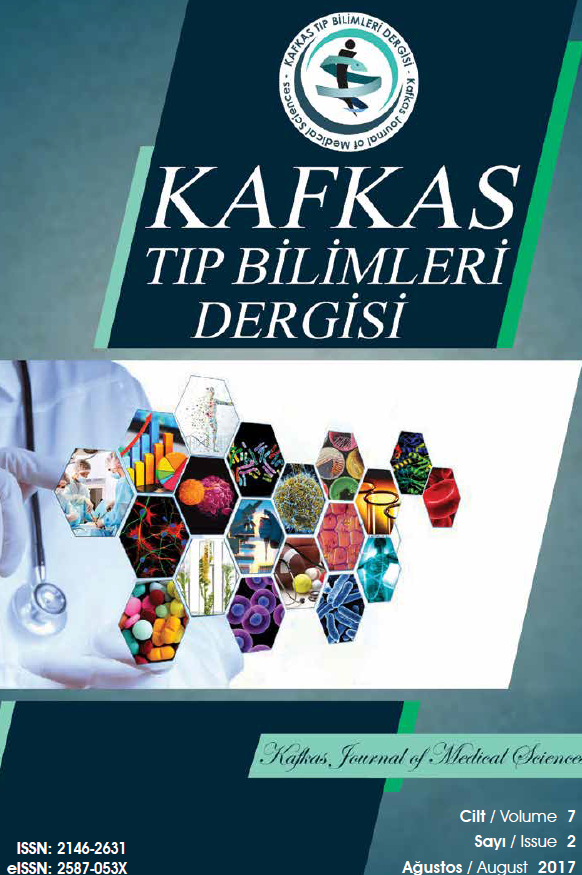Analysis of PD-L1 Immunohistochemistry Results for Different Sampling Procedures of Non-small Cell Lung Carcinoma. Can We Use Cell Blocks for Evaluation of PD-L1?
Analysis of PD-L1 Immunohistochemistry Results for Different Sampling Procedures of Non-small Cell Lung Carcinoma. Can We Use Cell Blocks for Evaluation of PD-L1?
PD-L1, tumor lung carcinoma, cell block,
___
- 1. Wang X, Teng F, Kong L, Yu J. PD-L1 expression in human cancers and its association with clinical outcomes. Onco Targets T her 2016; 12 (9):5023-39.
- 2. Shi SJ, Wang LJ, Wang GD, Guo ZY, Wei M, Meng YL, et al. B7-H1 expression is associated with poor prognosis in colorectal carcinoma and regulates the proliferation and invasion of HCT116 colorectal cancer cells. PLoS One 2013; 8(10):e76012.
- 3. Ohaegbulam KC, Assal A, Lazar-Molnar E, Yao Y, Zang X. Human cancer immunotherapy with antibodies to the PD-1 and PD-L1 pathway. Trends Mol Med. 2015;21(1):24–33.
- 4. Allison JP. Immune checkpoint blockade in cancer therapy: the 2015. Lasker-DeBakey Clinical Medical Research Award. JAMA. 2015; 314(11):1113–4.
- 5. National Comprehensive Cancer Network (2020). NCCN Clinical Practice Guidelines in Oncology, Small Cell Lung Cancer.
- 6. Zou, Y., Xu, L., Tang, Q. You Q, Wang X, Ding W, et al. Cytology cell blocks from malignant pleural effusion are good candidates for PD-L1 detection in advanced NSCLC compared with matched histology samples. BMC Cancer 2020; 20:344
- 7. Bubendorf L, Lantuejoul S, de Langen AJ, Thunnissen E. Nonsmall cell lung carcinoma: Diagnostic difficulties in small biopsies and cytological specimens. Eur Respir Rev. 2017;26: 170007.
- 8. Munari E, Zamboni G, Marconi M, Sommaggio M, Brunelli M, Martignoni G, et al. PD-L1 expression heterogeneity in nonsmall cell lung cancer: evaluation of small biopsies reliability. Oncotarget. 2017;8(52):90123–31.
- 9. Haragan A, Field JK, Davies MPA, Escriu C, Gruver A, Gosney JR. Heterogeneity of PD-L1 expression in non-small cell lung cancer: implications for specimen sampling in predicting treatment response. Lung Cancer. 2019;134: 79–84.
- 10. Wei Y, Zhao Q, Gao Z, Lao XM, Lin WM, Chen DP. The local immune landscape determines tumor PD-L1 heterogeneity and sensitivity to therapy. J Clin Invest. 2019;129(8):3347–60.
- 11. Bulutay P, Fırat P. (2021). Assessment: Küçük Hücreli Dışı Akciğer Karsinomlarında Farklı Koruyucu Solüsyonlar ile Oluşturulan Hücre Bloklarında PD-L1 Ekspresyonu. Paper presented at the 9th National Cytopathology Congress. 26-28 March 2021.
- 12. Kulac İ, Aydin A, Bulutay P, Firat P. Efficiency of Cytology Samples for PD-L1 Evaluation and Comparison with Tissue Samples. Turk Patoloji Derg. 2020;36(3):205-10.
- 13. Petrelli F, Maltese M, Tomasello G, Conti B, Borgonovo K, Cabiddu M, et al. Clinical and molecular predictors of PD-L1 expression in non-Small-cell lung Cancer: systematic review and meta-analysis. Clin Lung Cancer. 2018;19(4):315–22.
- 14. Pan Y, Zheng D, Li Y, Cai X, Zheng Z, Jin Y, et al. Unique distribution of programmed death ligand 1 (PD-L1) expression in east Asian non-small cell lung cancer. J Thorac Dis. 2017;9(8):2579–86.
- ISSN: 2146-2631
- Yayın Aralığı: Yılda 3 Sayı
- Başlangıç: 2011
- Yayıncı: Kafkas Üniversitesi
Does Subclinical Hypothyroidism Alter the Axis of QRS and P Waves?
Timor OMAR, Metin ÇAĞDAŞ, Mahmut YESİN, Doğan ILİS, Muammer KARAKAYALI, İnanc ARTAC, Mustafa AVCI, Hikmet Utku ODMAN, Yavuz KARABAĞ, Ibrahim RENCÜZOĞULLARI
Yesim UYGUN KIZMAZ, Mehmet Emirhan IŞIK, Cenk İNDELEN
The Cognitive Benefits of Playing Volleyball: A Systematic Review
Evrim GÖKÇE, Emel GUNES, Erhan NALÇACI
Melanotic Neuroectodermal Tumor of Infancy
Evaluation of Penetrating Keratoplasty Results: Initial Experiences
Mehmet Siraç DEMİR, Ersin MUHAFİZ, Yusuf EVCİMEN
The Role of Endosonography in Patients With Moderate and High Probability of Choledocholithiasis
Rasim Eren CANKURTARAN, Zahide ŞİMŞEK, Yusuf COŞKUN
Past to Present, Epidemiology of SARS-CoV-2 Infection and Ways of Treatment: A Review
